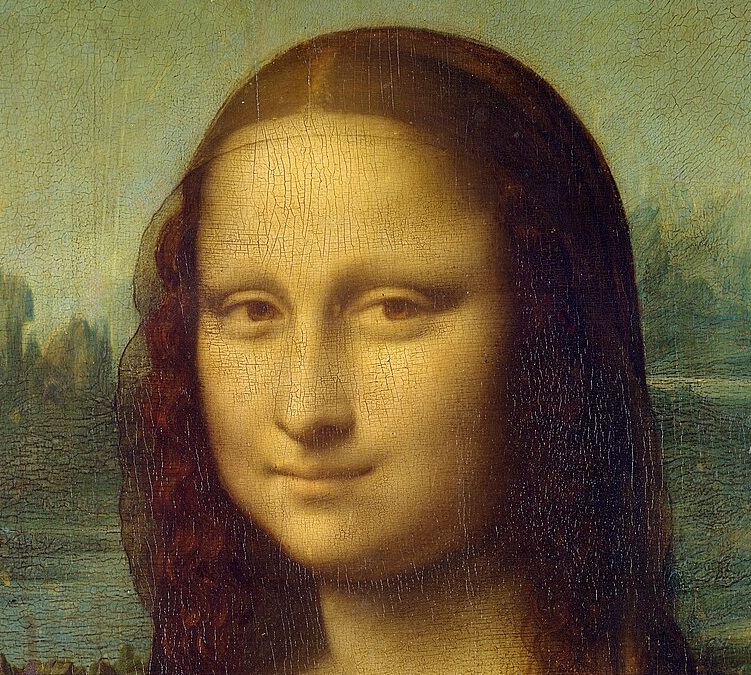
Sfumato is a painting technique developed during the Italian Renaissance, most famously used by Leonardo da Vinci. The term comes from the Italian word “sfumare,” meaning “to evaporate” or “to fade out.” This technique involves the delicate and subtle blending of colors and tones, such that there are no harsh lines or borders between them. It creates a soft, gradual transition between areas of light and shadow, resulting in a smoky or hazy effect that lends a realistic, three-dimensional appearance to the subject.
The use of sfumato allows for the depiction of fine details and complex facial expressions, adding depth, volume, and a sense of atmosphere to a painting. This technique is especially evident in Leonardo’s portraits, where it contributes to the lifelike quality and mysterious expressions of his subjects. Perhaps the most famous example of sfumato is seen in the Mona Lisa, where the technique is used to create the iconic, enigmatic smile and the almost imperceptible transitions between light and shade on her face and hands.
Sfumato represents a significant departure from the more linear and sculptural techniques used by earlier Renaissance artists, reflecting a deeper understanding of human anatomy, the subtleties of facial expression, and the interplay of light and shadow. It’s a testament to the artists’ mastery over their medium, allowing them to capture the nuances of the natural world and the complexities of human emotion with unparalleled realism.
Most Famous Examples of Sfumato Paintings
The use of sfumato, a technique characterized by the subtle blending of colors and tones to create a smoky effect and soft transitions between colors, is closely associated with Leonardo da Vinci and the Italian Renaissance. However, other artists have also utilized this technique to create depth and realism in their works. Here are some of the most famous examples of sfumato in paintings:
- “Mona Lisa” by Leonardo da Vinci (c. 1503-1506) – Perhaps the most iconic example of sfumato, the Mona Lisa’s enigmatic expression and the virtually imperceptible transitions between her facial features and the landscape behind her showcase Leonardo’s mastery of this technique. It is housed in the Louvre Museum, Paris.
- “Virgin of the Rocks” by Leonardo da Vinci (1483-1486) – This painting demonstrates sfumato through the gentle blending of the figures with the rocky landscape and the atmospheric perspective of the background. There are two versions of this painting, one in the Louvre and the other in the National Gallery, London.
- “Saint John the Baptist” by Leonardo da Vinci (1513-1516) – In this late work, Leonardo employed sfumato to create a soft, ethereal quality around Saint John, enhancing the spiritual and mystical atmosphere of the painting. It is also housed in the Louvre Museum.
- “La Belle Ferronnière” by Leonardo da Vinci (c. 1490-1496) – This portrait of an unknown woman, attributed to Leonardo, showcases the sfumato technique in the delicate rendering of the face and the seamless transition between the subject and the background. This painting can also be found in the Louvre Museum.
- “Madonna of the Yarnwinder” by Leonardo da Vinci and his workshop (c. 1501-1507) – Though there are several versions of this painting, attributed to Leonardo and his pupils, they all exhibit sfumato, particularly in the soft modeling of the faces and the integration of the figures with the landscape.
- “Lady with an Ermine” by Leonardo da Vinci (1489-1490) – This portrait combines Leonardo’s detailed observational skills with the use of sfumato to create a vivid yet softly blended depiction of Cecilia Gallerani, capturing the texture of her skin and fur with subtlety. It is located in the Czartoryski Museum, Kraków, Poland.
- “The Virgin and Child with Saint Anne” by Leonardo da Vinci (c. 1508-1510) – The sfumato technique is used to create a harmonious relationship between the figures and the landscape, imbuing the scene with a sense of depth and realism. This painting is also on display at the Louvre Museum.
These masterpieces highlight the effectiveness of sfumato in creating lifelike representations and atmospheric depth, showcasing the artists’ ability to capture the nuances of the natural world and human expression.